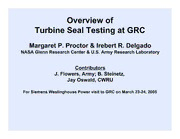
NASA Technical Reports Server (NTRS) 20060008698: Overview of Turbine Seal Testing at GRC PDF
Preview NASA Technical Reports Server (NTRS) 20060008698: Overview of Turbine Seal Testing at GRC
Overview of Turbine Seal Testing at GRC Margaret P. Proctor & Irebert R. Delgado NASA Glenn Research Center & U.S. Army Research Laboratory Contributors J. Flowers, Army; B. Steinetz, Jay Oswald, CWRU For Siemens Westinghouse Power visit to GRC on March 23-24, 2005 Turbomachinery Seal Development Objectives • Evaluate feasibility of advanced seal concepts and materials of meeting next generation engine speed and temperature requirements. • Provide a state-of-the-art turbomachinery seal test rig capable of testing seals under known and anticipated design conditions. • Work with industry to assess and demonstrate performance of their seals prior to test in engine. NASA Glenn Research Center Improved Non-contacting Finger Seal Features • Standard upstream fingers Intentional small clearance with rotor prevents upstream finger wear. • Lift pads only on downstream side Hydrostatic pressure may be adequate to provide lift. Lift grooves, which generate hydrodynamic lift during shaft rotation may be removed based on test results. • Pressure forces causes seal to lift preventing contact. • Small clearances promote low leakage. • Structural and fluid analysis being used to determine the design geometry and performance. Lift grooves On rotor Lift pad Upstream Finger NASA Glenn Research Center Non-Contacting Finger Seal Development - NASA GRC & U. of Akron Objective: A Develop non-contacting finger seal to overcome finger element wear and heat A generation for future turbine engine systems Approach: • Solid modeling for finger and pad motion/stresses • Fluid/solid interaction for leakage evaluation • Experimental verification Axial View of Staggered High/Low Pressure Fingers Assembly (View A-A) Status: • Developed a simplified spring-mass-damper model to assess seal’s dynamic response. Seal Prototype • CFD-ACE+ (3-D Navier-Stokes code) utilized to analyze the thermofluid behavior and to Downstream Fingers obtain stiffness and damping parameters. With Pads (Low P) • First prototype built: Testing underway Program: NASA/Univ. of Akron Coop. Agreement: Upstream Fingers Dr. Braun (U. of Akron) M. Proctor, Monitor (High P) NASA Glenn Research Center Finger Seal Equivalent Model for Dynamic Simulation – 2-DOF Fixed positions due to anchoring to the torroidal root k stick k Stick Finger Stick mass 3 m finger 1 4 2 5 k fluid c fluid 5 4 3 Moving 2 1 Boundary Fluid layer equivalent Spring +Damper a) b) Solid model and Equivalent Spring-Mass-Spring/Damper representation for use in the equation of motion simulation NASA Glenn Research Center High Temperature Turbomachinery Seal Test Rig • Test rig is designed to test at speeds and temperatures envisioned for next generation commercial and military turbine engines. • Test rig is one-of-a-kind. More capable than any known test rig in existence at either engine manufacturers or seal vendors. • Temperature Room temperature thru 1500 °F • Surface speed 1500 fps at 40,455 rpm, 1600 fps at 43,140 rpm • Seal diameter 8.5” design; 8.308 in. design; other near sizes possible • Seal types Air seals: brush, finger, labyrinth, film riding rim seals • Seal pressure 250 psig maximum, reduced by current air heater Current air heater flange limited to 125 psig at 1500 °F New Air Heater capable of 250 psig to be installed this spring • Motor drive 60 hp (60,000 rpm) Barbour Stockwell Air Turbine with advanced digital control for high accuracy/control NASA Glenn Research Center Test Parameters • Seal flow vs. pressure, speed, temperature (Both test rig and test seal are heavily instrumented) • Seal performance vs. simulated ramp cycles using new digital air turbine speed controller. Multiple speed step mission profile capabilities • Seal durability vs. once-per-rev rotor runout condition • Seal durability for prescribed seal offset condition (e.g. 3 mil seal offset) • Accelerated life tests • Seal and coating wear NASA Glenn Research Center Rig Features Unique Measurement Systems CD-97-76011 NASA Glenn Research Center Torquemeter • Installed between rig and air turbine • Torquetronic model ET10MS – Maximum torque rating of 22 Nm (16 ft-lb) – Maximum speed of 50,000 rpm – Absolute accuracy of 0.13 % • 0.029 Nm or 0.021 ft-lb • 0.032 Hp • Phase shift principle – Circumferential coil in stator ring provides toroidal flux path – Toothed shaft – teeth generate sinusoidal signals in stationary coils, whose phase displacement is directly proportional to shaft twist and hence torque. NASA Glenn Research Center High-Temperature, High-Speed Turbine Seal Rig Balance piston housing Torque-meter housing Bypass line Test Turbine section Seal exhaust line Seal supply line NASA Glenn Research Center
